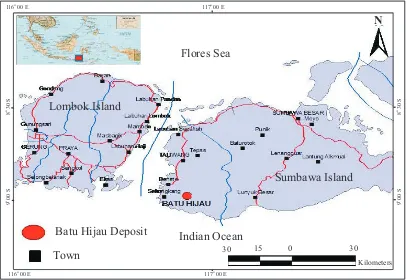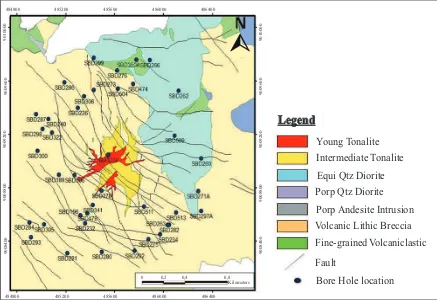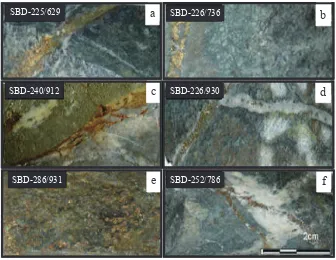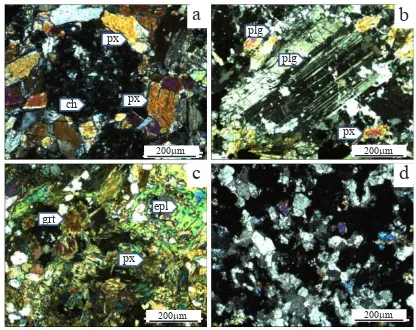Copper-Gold Bearing Skarn Mineralization at the Batu Hijau
Deposit, Sumbawa Island, Indonesia
Mineralisasi Skarn Pembawa Tembaga dan Emas pada Cebakan Batu
Hijau, Pulau Sumbawa, Indonesia
May Thwe Aye1,2, Akira Imai1, Naoto Araki1, Subagyo Pramumijoyo2, Arifudin Idrus2, Lucas Donny Setijadji2, dan Johan Arif3
1Department of Earth Resources Engineering, Kyushu University, Japan 2Department of Geological Engineering, Gadjah Mada University, Indonesia
3 Mine Geology Department, PT Newmont Nusa Tenggara, Indonesia
ABSTRACT
The Batu Hijau copper-gold skarn is located in the south western part of Sumbawa Island, Indonesia. An interaction of hydrothermal fluids associated with Early to Middle Miocene andesitic volcaniclastic rocks and Early to Middle Pliocene intermediate tonalite porphyry intrusion, formed a well-developed exo-skarn. No limestone is known in the Batu Hijau deposit. The skarn is typified by the presence of abundant garnet of andradite type, clinopyroxene (diopside-hedenbergite), opaque minerals as hematite and magnetite, and sulfides comprising chalcopyrite and pyrite. Typically, they are charac -terized by two main alteration stages based on a separate precipitation of calc-silicate minerals: (1) early prograde, followed by (2) later retrograde. During the prograde stage, metasomatism led to the formation of calcic-exoskarn consisting mainly of garnet (andradite-grossular) and pyroxene (diop-side-hedenbergite). On the other hand, the retrograde alteration is characterized by presence of epidote, calcite, quartz, and chlorite. Skarn mineralization is mostly concentrated along the brecciated magnetite zone during the retrograde stage. Prograde metasomatism commenced with segregation and evolution of a fluid phase in the pluton and its invasion into fractures and microfractures of the host rocks. It is structurally and lithologically controlled. According to texture and mineralogy, during the retrograde stage, the previously formed skarn zones were affected by intense multiple hydro-fracturing. Consequently, considerable amounts of hydrous calc-silicate mineral (epidote), sulfides (pyrite, chal -copyrite, galena, sphalerite, ±bornite), oxides (magnetite, hematite), and carbonates (calcite) replaced the anhydrous calc- silicates. Contemporaneous with the invasion of the early-formed skarn minerals then were partially altered to a series of very fine-grained aggregates of chlorite, magnetite, and calcite. Keywords: Cu-Au skarn, Batu Hijau, calcic-exoskarn, Sumbawa, Indonesia
SARI
INTRODUCTION
Batu Hijau, a world class porphyry Cu-Au deposit, is located at the southwestern part of Sumbawa Island, Province of West Nusa Tenggara, Indonesia (Figure 1). The deposit contains 914Mt of ore at an average grade of 0.53% Cu and 0.40g/t Au. Deep drilling in 2003 indicates the presence of skarn and gold-copper bearing skarn mineralization which interbedded with andesitic volcanic unit (Setyandhaka et al., 2008; Idrus et al., 2009). The proposed research will attempt to constrain the geological, mineralogical,
petrological, geochemical condition of skarn and skarn mineralization, and the genetically relationship between the skarn mineralization and porphyry Cu-Au sys-tem. The authors therefore tend to conduct a microscopic study and geochemical analysis as Ray Diffraction (XRD), X-Ray Fluorescence (XRF), Sacnning Elec-tron Microscopy (SEM/EDX), Actomic Absorption Spectro-photometry (AAS), fluid inclusion studies (FI), and Stable Isotopic studies. This study was focused on microscopic study (thin section and black polished section).
tahapan retrograde. Metasomatisme prograde dimulai dengan segregasi dan evolusi fase fluida di dalam pluton dan invasinya ke dalam rekahan dan rekahan mikro batuan induk tersebut. Peristiwa tersebut dikontrol oleh struktur dan litologi. Berdasarkan tekstur dan mineralogi, selama tahapan retrograde, zona skarn yang terbentuk sebelumnya dipengaruhi oleh retakan hidro berulang yang intensif. Akibat nya, sejumlah besar mineral kalk-silikat hidrat (epidot), sulfida (pirit, kalkopirit, galena, sfalerit, ± bornit), oksida (magnetit, hematit), dan karbonat (kalsit) menggantikan kalk-sili -kat anhidrat. Bersamaan dengan invasi mineral skarn yang terbentuk lebih awal, sebagian batuan terubah menjadi serangkaian agregat yang berbutir sangat halus seperti klorit, magnetit, dan kalsit.
Kata kunci: skarn Cu-Au, Batu Hijau, kalsik-eksoskarn, Sumbawa, Indonesia
30 15 0 30
Kilometers
Batu Hijau Deposit
Town
Indian Ocean
Sumbawa Island Lombok Island
116 00 E 116 00 E
117 00 E 117 00 E
o o
9 00 S
o
9 00 S
o
8 30 S
o
8 30 S
o
o o
N
Flores Sea
BACKGROUND GEOLOGY
The Batu Hijau deposit encompasses Early to Middle Miocene andesitic volcaniclastic units which are the most extensive rock unit in the deposit and they are gently dipping westward with locally contain thin interca-lations of limestone. The premineralization porphyritic andesitic intrusion and porphy-ritic stock and related dikes of porphyporphy-ritic quartz diorite were continuously intruded by equigranular quartz diorite and multiple phases of tonalite intrusion (Clode et al., 1996; Garwin, 2002). Figure 2 illustrates the geological map of the Batu Hijau de-posit. These andesitic volcaniclastic units are cross-cut by the earliest phase porphyritic andesite. The tonalite porphyry intrusions occupy the central part of the Batu Hijau deposit and form a steeply dipping cluster of upward tapering, north-northeasterly-elongate, conical stocks. Along the contact
between the andesitic volcanic unit and the equigranular quartz diorite, the tonalite porphyries were emplaced. The Batu Hiaju porphyry copper-gold mineralization system is centred on, and spatially and temporally related with this tonalite porphyry intrusion complex. (Clode et al., 1996; Garwin, 2002).
CHARACTERISTICS OF SKARN AND SKARN MINERALIZATION
The skarn mineralization occurs at the deep level of the Batu Hijau porphyry copper-gold deposit. Skarn-type metasomatic al-teration and mineralization occur along the contact between the andesitic volcaniclastic unit and the tonalite porphyry intrusion and it can be found at the elevation of -450 to >-1000 m relative to sea level.
The typical characteristics of skarn in Batu Hijau deposit is green, reddish brown,
Figure 2. Geological map of Batu Hijau deposit. Circles show the bore hole location of skarn mineralization.
Legend
Young Tonalite Intermediate Tonalite Equi Qtz Diorite Porp Qtz Diorite Porp Andesite Intrusion Volcanic Lithic Breccia Fine-grainedVolcaniclastic Fault
Bore Hole location
484800 485200 485600 486000 486400
9010000
9009600
9009200
9008800
9008400
484800 485200 485600 486000 486400
9010000
9009600
9009200
9008800
9008400
0 0,2 0,4 0,8
locally black in colour and fine-grained
showing layers of colour banding, brec-ciated nature, and massive in some. The
green layers predominantly consist of fine-to
medium-grained clinopyroxene (diopside and hedenbergite) and the reddish-brown layers are mainly composed of garnet (an-dradite-grossularite), whereas white layers
are chiefly composed of calcite and quartz.
Ca-rich plagioclase (anorthite), quartz, epi-dote, and chlorite can also be recognized.
The type of skarn can be classified as exoskarn because of the abundances of pyroxene-garnet minerals. The process of skarn formation occurrs in two stages: (1) prograde and (2) retrograde. The pro-grade skarn is typically characterized by
the reddish-brown coloured, fine-grained
garnet (andradite) which shows banded nature with others and greenish coloured clinopyroxene (diopside-hedenbergite) at high temperature of 340 ->400oC by high salinity fluid of 35-45 NaCl wt% eq based
on fluid inclusion thermometry. On the other hand, calcite, epidote, chlorite, and quartz represent the retrograde stage which is formed at low temperature of 280 - 300oC by low salinity fluid of 1-10 NaCl wt% eq
(Idrus et al., 2009). Prograde metasomatism commenced by segregation and evolution
of a fluid phase in the pluton and its inva -sion into fractures and micro-fractures of the host rocks. According to texture and mineralogy, during the retrograde stage, the previously formed skarn zones were affected by intense multiple hydro-fracturing. Con-sequently, considerable amounts of hydrous calc-silicate mineral (epidote), sulfides (pyrite, chalcopyrite, galena, sphalerite, ± bornite), oxides (magnetite, hematite), and carbonates (calcite) replaced the anhydrous skarn minerals. Contemporaneous with the invasion of the early-formed skarn miner-als, they were partially altered to a series
of very fine-grained aggregates of chlorite,
hematite, and calcite.
Skarn ore mineralizations are generated in the retrograde stage. Photographs of representa-tive drill core samples showing the typical texture of skarn and nature of occurrences of skarn ore mineralization are shown in Fig-ures 3 and 4. Various types of anhydrous and hydrous calc-silicates (garnet, diopside, am-phibole, epidote), silicates (chlorite, quartz,
clay minerals), sulfides (pyrite, chalcopyrite,
sphalerite, galena, bornite), oxides (magne-tite, hematite), and carbonates (calcite) were developed during sequential stages of
skarni-fication processes in the skarn zones along
the contact between andesitic volcanic unit and the tonalite porphyry intrusion.
Garnet occurs ubiquitously in the skarn
zone as fine-to coarse-grained, anhedral
to euhedral crystals. Quartz/calcite veins and veinslets are cutting across the garnet-pyroxene skarn (Figures 5b and 5c). Most garnet crystals display concentric zoning (Figure 5d) occuring as patchy aggregates with conspicuous growth zoning, and are isotropic. Furthermore, it was recognized as one of representative minerals which corresponds to prograde stage. Most of the garnets partially, to entirely alter to epidote, calcite, quartz, chlorite, and clay minerals mainly along fractures and microfractures.
Pyroxene occurs as fine-grained, anhedral
Figure 3. Photograph showing the typical features of skarn: (a) banded nature of pyroxene and garnet, (b) quartz vein across cutting the pyroxene abundance skarn, (c) quartz calcite vein which includes ore mineraliza-tion cross cutting the garnet abundance skarn with some epidote, (d) quartz/calcite and magnetite veinlets cut across the coarse-grained garnet and pyroxene skarn, (e) the contact nature of intermediate tonalite and skarn, and (f) massive nature of garnet cross cut by quartz vein near brecciated zone.
Figure 4. Photograph showing the occurrences of skarn ore mineralization (a,b,d, and f) showing the vein type skarn mineralization, (c) massive nature of pyrite along the contact of intermediate tonalite and skarn, and (e) disseminated nature of skarn mineralization at the broken magnetite zone.
SBD-271/650
SBD-240/741
SBD-252/873
SBD-260/572 SBD-263/670
SBD-260/930
a b
c d
e f
SBD-240/912
SBD-286/931
SBD-226/930
SBD-225/629 SBD-226/736
SBD-252/786
a b
c d
As it was reported that an assemblage of bornite and chalcopyrite is common in prin-cipal ores in porphyry copper-gold deposits
in western Pacific island arcs (Imai, 2001,
2005), bornite and chalcopyrite have also been recognized in the porphyry copper-gold deposit, Batu Hijau (Arif and Baker, 2004; Imai and Ohno, Imai and Nagai, 2009). However, the presence of bornite in the 19 drill hole samples collected from the
skarn mineralization zone was not identified.
It implies that bornite was not stable under the condition, and only chalcopyrite that could occur. Magnetite is the most abundant in the brecciated zone occuring as broken ore minerals and massive aggregates, and as veinlets within the skarn. Magnetite replaces pyrite (Figure 7b) and in turns is replaced partially by chalcopyrite and sphalerite. Magnetite coexists with ore minerals and is predominant over the others. In addition, the average of Cu concentration is relatively high among the chosen boreholes. This may
Figure 5. Photomicrograph of (a) pyroxene vein cut across the pyroxene-garnet skarn, (b) quartz vein cutting the pyroxene abundance skarn, (c) quartz/ calcite veinlets cutting across the garnet abundance skarn, and (d) concentric zonning in coarse-grained garnet (cross polarized light).
Figure 6. Photomicrograph of (a) sheet texture of pyroxene, (b) plagioclase show twinning nature (c) partial alteration of clinopyroxene by amphibole, and (d) pyroxene showing decussate texture (cross polarized light)
Figure 7. Photomicrograph of opaque bearing skarn ore minerals (Polarized reflected light)
suggest that the mineralization here is related to magnetite. Proffett (2003) and Setyandhaka et al. (2008) also stated that the highest grade of copper and gold occur in the broken
mag-netite zone, which is commonly defined as
skarn mineralization interval. In other words,
it is likely that magnetite formed at first,
pyrite then formed surrounding magnetite,
and finally chalcopyrite filled the interstices.
Imai and Nagai’s research (2009) differs from this result in that blebs of chalcopyrite (and bornite) inclusions and in magnetite grains in their drill hole samples. Blebs of native gold were recognized in chalcopyrite (Figure 7d). Pyrite is relatively abundant minerals and is present mainly within calc-silicates as massive and dispersed patchy aggregates and/ or as veinlets and microveinlets.
DISCUSSION AND CONCLUSION
Skarn zones were developed along the contact of the andesitic volcaniclastic unit with intermediate tonalite porphyry intru-sion. Field evidence, analytical data, and mineralogical and textural criteria show that
in the studied area genetically skarnification
processes and their evolutionary trend can be categorized into two discrete stages: (1) prograde and (2) retrograde. The alteration progressed isochemically by the effect of
heat flowing from the pluton into the sur -rounding andesitic volcaniclastic rocks. In general, some anhydrous calc-silicates are in proximity to the contact (higher tem-perature), and some hydrous minerals at distances were developed by metasomatic processes from clay-rich carbonate inter-layers during this stage. In general, the de-velopment of calc-silicates is accompanied by decarbonation reactions which cause a slight volume decrease and the subsequently formation of fractures and microfractures in the host rock. Almost no opaque minerals
(oxides and sulfides) were formed during
the prograde stage.
Prograde metasomatic alteration com-menced with the beginning of crystallization and consolidation and concurrent separation
of high temperature fluids. The invasion and infiltration of such fluids into secondary
fractures, resulted from both decarbonation reactions and hydro-fracturing processes, transferred noticeable amounts of Fe, Si, and Mg to the skarn zones. The introduc-tion of these elements caused the further progression of the decarbonation processes and the formation of a series of medium- to coarse-grained anhydrous calc-silicates
within a fine-grained matrix. Garnets and
pyroxenes formed during prograde stage are mainly andraditic and hedenbergitic in com-position, respectively, which may be due to the introduction of considerable amounts
of Fe into the skarn system by the invading
fluids. Textural relationships indicate that
opaque minerals were not formed during the prograde stage.
During the retrograde stage, in addition to Fe, Si, and Mg, considerable amounts of Cu
as sulfides along with volatile constituents
were also added to the skarn system,
moti-vating a series of hydrolysis, sulfidation, and
carbonation reactions within the anhydrous calc-silicates. As a result of these reactions, considerable amounts of hydrous
calc-sili-cates (epidote), sulfides (pyrite, chacopyrite,
and sphalerite), oxides (magnetite, hematite), and carbonates (calcite) replaced the early formed anhydrous calc-silicates. The early formed mineral assemblages were altered to
a series of fine-grained aggregates of chlorite, hematite, calcite, and clay chiefly along frac -tures and micro- frac-tures by a relatively low temperature during the retrograde alteration.
ACKNOWLEDGEMENTS
This research is partially supported by JICA (Japan International Cooperation Agency). Thanks are also due to the management of PT. Newmont Nusa Teng-gara for the permission to conduct the field investi -gation and for the helps during the field work at the Batu Hijau mine in carrying out this research work.
REFERENCES
Clode, C.,Proffett, J.,Mitchell, P., and Munajat, I., 1996. Relationships of intrusion, wall-rock alteration and mineralization in the Batu Hijau copper-gold porphyry deposit, in 1999 Pacrim Congress, Bali, Indonesia. Australian Institute of Mining and Met -allurgy, Proceedings, Publication Series No 4/99, p.485-498.
hijau porphyry copper-gold deposit, Sumbawa, Indonesia. Society of Economic Geologist, Special
Publication 9. p. 333-366.
Idrus, A., Kolb, J., Meyer, F. M., Arif, J., Setyand-haka, D., and Keply, S., 2009. A preliminary study on skarn-related calcsilicate rocks associated with the Batu hijau porphry copper-gold deposit, Sumbawa Island, Indonesia. Resource Geology, vol. 59 (3), p. 295-306.
Meinert, L.D., 2000. Gold in skarns related to epizo-nal intrusions. In: Hagemann, S.G., and Brown, P.E. (Eds.), Gold in 2000. Reviews in Economic Geology, 13, p. 347-375.
Proffett, J.M., 2003. Review of deep drilling results at Batu Hijau. Unpublished Newmont Nusa Tenggara
Company Report. PT. Newmont Nusa Tenggra, Batu
Hijau project, Sumbawa, Indonesia. 6pp.



